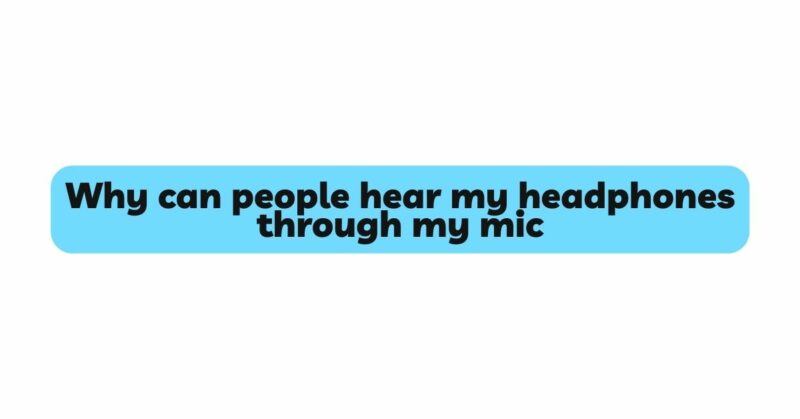In an era where communication and multimedia consumption are deeply intertwined with technology, the phenomenon of headphone audio leaking into microphones has become a common yet perplexing issue. This occurrence, often resulting in an unintentional blending of personal audio and external communication, can be both embarrassing and frustrating. In this article, we will delve into the intricacies of this phenomenon, exploring the underlying reasons for why people can hear your headphone audio through your microphone, the contributing factors, and potential solutions to mitigate or prevent such occurrences.
I. The Nature of Sound and Microphone Sensitivity
- Sound Propagation: Sound travels through air as pressure waves. When you’re using headphones, the audio is channeled into your ears, creating vibrations in the air around you. These vibrations have the potential to spread and interact with objects in your environment, including the microphone.
- Microphone Sensitivity: Microphones are designed to capture even the faintest of sounds. Their high sensitivity allows them to pick up audio signals from various sources, including external sounds not intended to be captured. This sensitivity, while desirable for accurate recording, can inadvertently lead to headphone audio leakage.
II. Mechanical Coupling and Sound Isolation
- Mechanical Coupling: Physical objects, such as the headband of your headphones or even your body, can act as conduits for sound vibrations. When sound from your headphones reaches these objects, it can be transmitted to the microphone through mechanical coupling, effectively turning your headphones into a pathway for audio leakage.
- Sound Isolation Challenges: Achieving complete sound isolation is challenging due to the nature of sound waves. Even high-quality headphones with excellent noise isolation properties cannot entirely prevent sound waves from interacting with the environment. This is especially true for low-frequency sounds that have longer wavelengths and can penetrate through materials.
III. Open-Back vs. Closed-Back Headphones
- Open-Back Headphones: Open-back headphones are designed with perforated ear cups that allow airflow, resulting in a more natural and open sound. However, this design also allows sound to escape from the ear cups, potentially reaching the microphone. While open-back headphones provide a spacious soundstage, they are more prone to audio leakage.
- Closed-Back Headphones: Closed-back headphones feature sealed ear cups that prevent sound from escaping and external sound from entering. This design minimizes the risk of headphone audio leaking into the microphone. If audio leakage is a concern, opting for closed-back headphones can help mitigate the issue.
IV. Microphone Placement and Headphone Volume
- Microphone Placement: The location of your microphone in relation to your headphones plays a significant role in audio leakage. If the microphone is positioned in close proximity to the headphones, it’s more likely to pick up sound from them. Proper microphone placement and isolation techniques can help reduce this effect.
- Headphone Volume Levels: Listening to audio at high volumes through headphones increases the intensity of sound vibrations that can potentially leak into the microphone. Lowering the volume can minimize the vibrations transmitted to external objects and subsequently to the microphone.
V. Software and Digital Audio Processing
- Noise Cancellation and Echo Cancellation: Some communication software and applications offer noise cancellation and echo cancellation features. These technologies aim to suppress unwanted audio, including sound leakage from headphones. While they can be effective, their success depends on the software’s algorithms and the specific audio characteristics.
- Microphone Sensitivity Settings: Adjusting the sensitivity settings of your microphone can help mitigate audio leakage. By lowering the sensitivity, you reduce the chances of capturing faint sounds, including those leaking from your headphones.
VI. Preventive Measures and Solutions
- Use Closed-Back Headphones: Opt for closed-back headphones, as they provide better isolation and minimize the risk of audio leakage. Their sealed design prevents sound from escaping and reduces mechanical coupling.
- Microphone Isolation: Use a microphone stand or arm to position the microphone away from your headphones. This reduces the chances of the microphone picking up vibrations transmitted through mechanical coupling.
- Volume Management: Maintain a moderate headphone volume to reduce the intensity of vibrations. This not only minimizes audio leakage but also protects your hearing.
- Noise Isolation Techniques: Consider using noise isolation materials, such as foam or acoustic panels, around the microphone to block external vibrations and sound waves.
VII. Conclusion
The curious phenomenon of headphone audio leakage into microphones arises from the intricate interplay of sound waves, microphone sensitivity, and mechanical coupling. As technology advances, manufacturers are continuously working to design headphones and microphones with improved isolation and more effective noise cancellation algorithms. Until then, understanding the factors contributing to audio leakage and implementing preventive measures can help users minimize this issue. By choosing the right headphone design, adjusting microphone settings, and being mindful of volume levels, individuals can ensure a more focused and private audio experience, whether it’s for communication, content creation, or entertainment.


